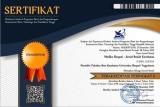IDENTIFIKASI JENIS CACING SOIL TRANSMITTED HELMINTH (STH) PADA FESES PEKERJA PENGANGKUT SAMPAH KOTA KENDARI DENGAN METODE MODIFIKASI HARADA MORI DAN METODE MODIFIKASI KATO KATZ
Abstract
Background: helminthiasis is classified as negleted disease, which is an infection that is not considered and is chronic without causing clear clinical symptoms and its effects can only be seen in the long term. Objective: to identify the types of worms in the feces of Kendari garbage transportation workers. Methods: uses laboratory observation methods to identify the type of Soil that is Contagious. Using 42 stool samples that have been stored for ± 2 months were taken from the stools of Kendari municipal waste workers and examined using the modified kato-katz, Harada Mori and Direct slide methods. Results: the results of various inspection methods namely, direct slide, Kato-katz modification and Harada Mori modification. Identification of the egg stage, the p-value is 0.002 <α = 0.05. This shows that the Kato-katz method is far better than the direct shear method in the examination of STH worm eggs. The p-value results in the examination of Harada mori larvae and the direct shear value were 0.001 <α = 0.05. This shows that the Harada mori method is better at identifying fecal larvae than the direct glide method. The Kato-Katz modification method is more effective in identifying the type of worm egg than the direct slide method. The most common type of Transmitted Helminth earthworm identified in this study is hookworm. Conclusion: The Kato Katz method is a better method used than the direct slide method in identifying the type of Soil transmitted Helminth (STH) in the egg phase. Harada mori is a better method used than the direct slide method in identifying the type of Soil transmitted Helminth (STH) worm in the larval phase. The type of STH worm most identified in this study is the hookworm.
Keywords
Full Text:
PDFReferences
Burat, B. (2014). Hubungan Hygiene Perorangan dan Pemakaian Alat Pelindung Diri dengan Keluhan Gangguan Kulit dan Kecacingan Pada Petugas Pengangkut Sampah Kota Pematangsiantar. Jurnal Lingkungan Dan Kesehatan Kerja, 3(2), 1–7.
Direktorat Jenderal Pengendalian dan Penyehatan Lingkungan. (2015). Profil pengendalian dan Penyehatan Lingkungan. Jakarta: Direktur Jenderal Pengendalian-Penyehatan Lingkungan.
Entianopa, Ranissa DwiImansari, & Rachman, I. (2017). Faktor Risiko Kejadian Penyakit Kulit Pada Pekerja Pengangkut Sampah Di Kota Jambi. Jurnal Riset Informasi Kesehatan, 6(2), 129–135.
Gandahusada, S. W. P. dan H. (2008). Parasitologi Kedokteran. Jakarta: EGC.
Halleyantoro, R., Riansari, A., & Dewi, D. P. (2019). Insidensi dan Analsisi Faktor risiko Infeksi Cacing Tambang. Jurnal Kedokteran Raflesia, 5(1), 18–27.
Irawati. (2013). Hubungan Personal Hygiene dengan Cacingan Pada Anak di Wilayah Kerja Puskesmas Tamangapa Antang Makassar. Universitas Islam Negeri Alauddin Makassar.
Mackey, T. K., Liang, B. A., Cuomo, R., Hafen, R., Brouwer, K. C., & Lee, D. E. (2014). Emerging and reemerging neglected tropical diseases: A review of key characteristics, Risk factors, And the policy and innovation environment. Clinical Microbiology Reviews, 27(4), 949–979. https://doi.org/10.1128/CMR.00045-14
Marhani. (2012). Studi DiagnostikPemeriksaan Feses Menggunakan Metode Direct Slide Dengan Metode Konsentrasi Dalam Menegakkan Diagnosis Kecacingan. Universitas lampung.
Martila, M., Sandy, S., & Paembonan, N. (2016). Hubungan Higiene Perorangan dengan Kejadian Kecacingan pada Murid SD Negeri Abe Pantai Jayapura. Jurnal Plasma, 1(2), 87–96. https://doi.org/10.22435/plasma.v1i2.4538.87-96
Pratiwi, A. S. (2015). Hubungan Infeksi Soil-Transmitted Helminth dengan Malnutrisi dan Anemia pada Anak The Relationship between Soil-Transmitted Helminth infection with Malnutrition and Anemia in Children. J Agromed Unila, 2(4), 377–380.
Ruberanziza, E., Owada, K., Clark, N. J., Umulisa, I., Ortu, G., Lancaster, W., … Soares Magalhães, R. J. (2019). Mapping soil-transmitted helminth parasite infection in Rwanda: Estimating endemicity and identifying at-risk populations. Tropical Medicine and Infectious Disease, 4(2). https://doi.org/10.3390/tropicalmed4020093
Siregar, M. (2012). Kejadian Infeksi Cacing Dan Gambaran Kepemilikan Jamban Dan Air Bersih Pada Anak Usia Sekolah Dasar Di Yayasan Nanda Dian Nusantara 2011. Universitas Islam Negeri.
Sofia R. (2017). Perbandingan Akurasi Pemeriksaan Metode Direct Slide dengan Metode Kato-KATZ Pada Infeksi Kecacingan. Jurnal Avverous, 3(1), 1–14.
Sulmayani Suluwi,Farit Rezal, C. S. I. (2017). Pengaruh penyuluhan dengan metode permainan edukatif sukata terhadap pengetahuan, sikap dan tindakan tentang pencegahan penyakit cacingan pada siswa kelas iv dan v sd negeri 1 mawasangka kabupaten buton tengah tahun 2016. Jimkesmas, 2(5), 1–10.
Sumanto D. (2010). Faktor risiko Infeksi Cacing Tambang Pada Anak Sekolah. Universitas Diponegoro.
DOI: https://doi.org/10.35842/mr.v15i1.270
Article Metrics
Abstract view : 1863 ViewPDF - 664 View
Refbacks
- There are currently no refbacks.
Copyright (c) 2020 Arimaswati Arimaswati, La Ode Alifariki, Faning Fridayani, Jamaluddin jamaluddin
Medika Respati : Jurnal Ilmiah Kesehatan indexed by:








